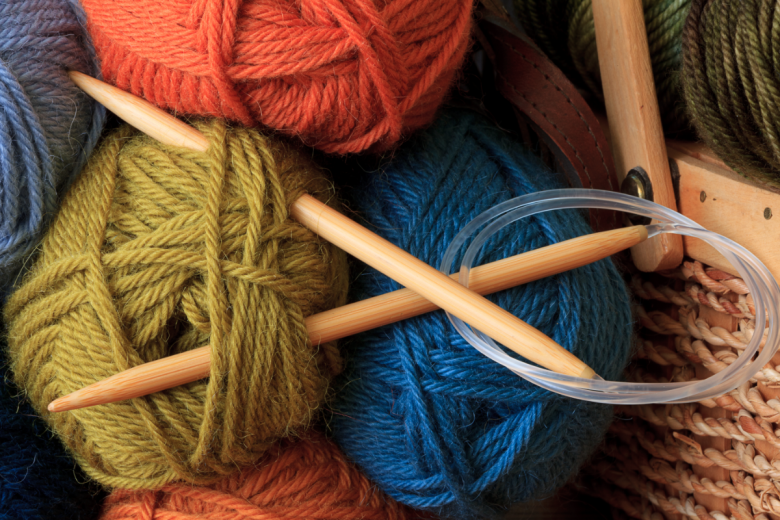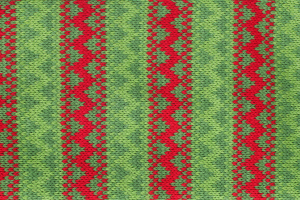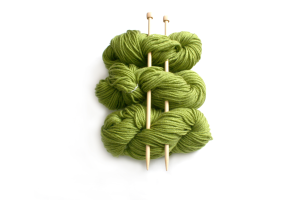Circular needles are a pair of knitting needles connected by a flexible cable. These needles come in a variety of sizes and lengths, making them ideal for projects that require knitting in the round, such as hats, sleeves, and socks. Unlike straight needles, circular needles allow you to knit continuously in a circular shape without having to turn your work.
Circular needles are an essential tool for knitters who want to create seamless and professional-looking projects. The flexibility of the cable allows you to work with larger or smaller circumferences, making them a go-to choice for knitting a wide range of items, from cozy scarves to intricate lace shawls. With circular needles, you can easily knit both small and large projects without worrying about losing stitches off the edges, a common issue with straight needles.
Another benefit of using circular needles is their ability to distribute the weight of the project evenly across the cable, reducing the strain on your hands and wrists. This makes circular needles especially useful for long-term projects, such as blankets or large sweaters, where the weight of the fabric can be a challenge to manage on traditional straight needles. Whether you are a beginner or an experienced knitter, mastering circular needles will enhance your knitting experience and open up a wide array of possibilities for your creative projects.
Circular needles also allow for more efficient use of yarn, as the continuous loop means fewer joins and less tangling compared to using multiple straight needles. This is particularly advantageous when working with colorwork or stripes, as it creates a cleaner, more polished finish. Plus, they are easier to carry and store, making them an ideal choice for knitting on the go.
Why Use Circular Needles?
Circular needles are popular for their versatility and comfort. They distribute the weight of your project more evenly, reducing strain on your wrists and hands. Additionally, circular needles are a great tool for both small and large projects, as you can use them for knitting in the round or flat (by knitting back and forth).
Choosing the Right Circular Needles for Knitting in the Round
Needle Size
The size of your circular needles will depend on the pattern you are working on. Needle sizes are typically measured in millimeters or U.S. standard sizes. Be sure to check your pattern for the recommended needle size and use the right size to achieve the correct gauge.
Cable Length
Circular needles come in various cable lengths, typically ranging from 16 inches to 40 inches. Shorter cables (around 16-24 inches) are perfect for small projects like hats, while longer cables (32 inches or more) are great for larger items like sweaters. When choosing a cable length, keep in mind the circumference of your project.
Understanding the Basics of Knitting in the Round
What Does Knitting in the Round Mean?
Knitting in the round involves working in a continuous circle without turning your work. This technique is commonly used to create tubular shapes, such as sleeves, socks, and hats. Unlike flat knitting, there are no seams to sew up at the end, which saves time and effort.
Types of Circular Knitting Projects
Circular needles are great for a variety of projects. Some common items knitted in the round include:
- Hats: Knit seamlessly without the need for seaming.
- Socks: Knit a sock from toe to cuff, all in one piece.
- Sweaters: Knit the body and sleeves in the round before joining them.
- Shawls: Knit circular shawls that grow outward from the center.
How to Cast On for Circular Knitting
Basic Cast-On Methods
When knitting in the round, you’ll need to cast on stitches. There are several methods for casting on, but a simple and common method is the long-tail cast-on. Make sure you cast on an even number of stitches if you plan to work in a pattern like ribbing.
Joining in the Round Without Twisting
Once you’ve cast on your stitches, the next step is to join them in the round. This is crucial because if your stitches are twisted, your work will be impossible to complete. To avoid twisting, carefully check that your cast-on stitches are all facing the right direction before joining.
Starting Your Round: The First Row
Working the First Row in the Round
To start knitting in the round, you’ll need to work your first row. Hold the needle tips in each hand and start knitting, making sure your stitches are all oriented correctly. As you work, ensure that the stitches are aligned evenly along the circular needle.
Avoiding Common Mistakes
One common mistake when starting the first round is twisting the stitches. This happens when you accidentally rotate your stitches after casting on. Always double-check before joining to ensure that your work is not twisted.
How to Knit Using the Magic Loop Technique
What is the Magic Loop?
The Magic Loop technique allows you to knit small circumferences, such as the top of a hat or socks, using a long circular needle. This technique uses the flexibility of the cable to create a loop, enabling you to work with only a few stitches at a time.
Step-by-Step Magic Loop Instructions
To use the Magic Loop technique:
- Cast on your stitches and divide them evenly between the two halves of the needle.
- Pull the cable through so that one half of your stitches are on one side of the loop and the other half is on the other side.
- Start knitting with the first set of stitches, then slide them back to the middle, pulling the cable through to knit the second set of stitches.
Working with Double-Pointed Needles vs. Circular Needles
When to Choose Double-Pointed Needles
Double-pointed needles (DPNs) are another popular tool for knitting in the round. They are great for smaller projects that require more precision, such as socks. However, circular needles are generally preferred for larger projects due to their ability to hold more stitches.
Benefits of Circular Needles for Round Knitting
Circular needles provide several advantages, including the ability to hold a large number of stitches comfortably. They are also easier to use for projects like sweaters and shawls, where you need to keep your stitches organized without worrying about the needles slipping out.
Knitting in the Round with Colorwork
Introducing Colorwork Techniques
Colorwork is a technique where you knit with two or more colors of yarn. Popular methods include fair isle and intarsia. When knitting in the round, colorwork can create beautiful patterns and designs that are continuous and seamless.
Tips for Managing Multiple Yarns
When working with multiple colors, it’s important to manage your yarns carefully. One tip is to keep your yarns on separate bobbins or balls to avoid tangling. Additionally, you may want to twist the yarns at the back of your work to avoid holes or gaps between the colors.
Decreasing Stitches in the Round
Common Decrease Techniques
Decreasing in the round is necessary for shaping projects like socks or hats. Common decrease techniques include knit two together (K2tog) and slip, slip, knit (SSK). Each technique will create a different type of decrease, so be sure to follow your pattern’s instructions.
When to Decrease in the Round
Decreases are usually worked at regular intervals, such as every few rounds. Pay attention to your pattern to ensure that decreases are made at the right points in the project.
Knitting Larger Items in the Round
Handling Larger Circumferences
For larger items like sweaters, you may need to adjust your approach when knitting in the round. Consider using longer cables for projects with wider circumferences. You can also work with a combination of circular needles and DPNs for smaller areas like sleeves.
Tips for Comfort During Long Sessions
Knitting large projects can strain your hands and wrists. Make sure to take regular breaks and stretch your hands to avoid discomfort during long knitting sessions.
How to Bind Off Knitting in the Round
Standard Bind Off Method
Binding off in the round is the final step of your project. Simply knit your stitches and then pass each stitch over the previous one, working your way around. Be careful not to pull the stitches too tight, as this can lead to a stiff edge.
Loose Bind Off for Stretchy Edges
If you need a stretchier edge, such as for the brim of a hat, use a loose bind-off technique. This will ensure that the edge is flexible and comfortable without being too tight.
Troubleshooting Common Circular Knitting Problems
Twisted Cast-Ons
A twisted cast-on happens when your stitches are not aligned properly before joining in the round. Always double-check your cast-on before starting the first round.
Tight Stitches on the Cable
If your stitches seem too tight on the cable, it might be due to using a cable that’s too short. Try a longer cable to give your stitches more room to stretch out.
Cleaning and Caring for Your Circular Needles
How to Care for Wooden Needles
Wooden needles can be delicate. To keep them in good condition, wipe them down regularly with a soft cloth and avoid exposing them to extreme temperatures or moisture.
Tips for Cleaning Metal Needles
Metal needles are more durable but still require regular cleaning to prevent buildup. Simply wash them with mild soap and warm water, then dry them thoroughly.
Advanced Circular Knitting Techniques
Two-at-a-Time Socks
Two-at-a-time socks are a fun and efficient way to knit both socks simultaneously. This technique requires using a longer circular needle and the Magic Loop method for each sock.
Magic Loop with Two Circles
For even larger projects, you can use two circular needles to knit in the round. This technique allows you to handle the stitches more comfortably without worrying about your work getting tangled.
Mastering Knitting in the Round
Knitting in the round with circular needles opens up a world of possibilities for seamless and beautiful projects. With the right techniques and a little practice, you can create anything from socks to sweaters with ease. Take the time to explore different methods like Magic Loop and colorwork, and don’t forget to troubleshoot common problems as they arise.
Knitting in the round with circular needles not only simplifies the construction of garments but also allows for more intricate designs that would be difficult with flat knitting. By mastering this technique, you can create garments that fit perfectly without the need for seaming, which can be time-consuming and challenging for beginners. Whether you’re working with delicate lace patterns or experimenting with bold color combinations, circular needles offer a versatile and efficient way to bring your knitting ideas to life.
As you gain confidence, don’t be afraid to experiment with different stitch patterns, yarns, and techniques. The flexibility of circular knitting means that you can continuously expand your skills and challenge yourself with more complex projects. Whether you’re knitting accessories, home décor, or even blankets, the possibilities are endless when you embrace the circular needle.
Remember that practice is key, and every project you complete will help you become more skilled and comfortable with knitting in the round. So, continue exploring, learning, and enjoying the process—it’s all part of the knitting journey. With each stitch, you’re not just creating a piece of fabric; you’re crafting something unique and personal. Happy knitting, and may your projects bring you joy and satisfaction!




